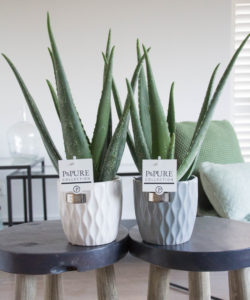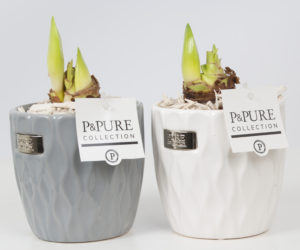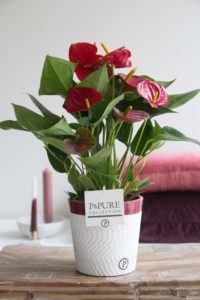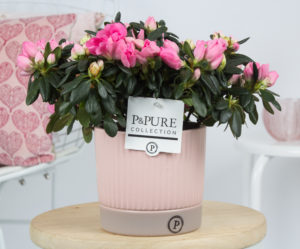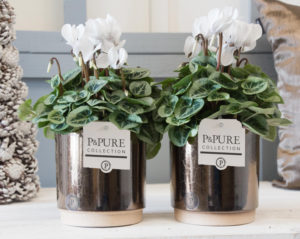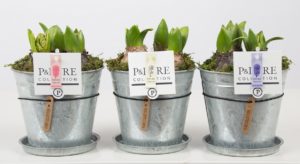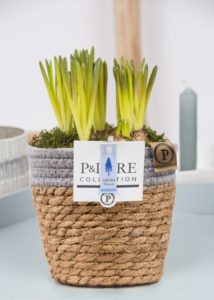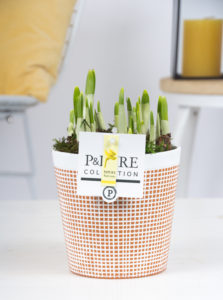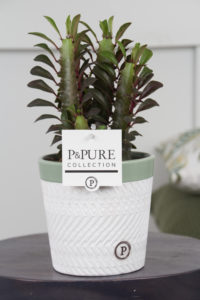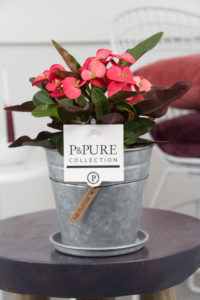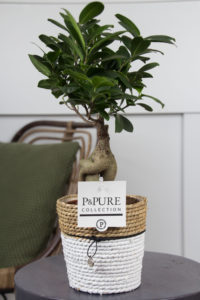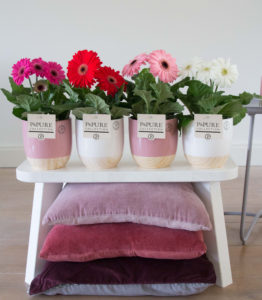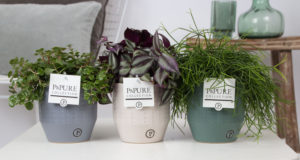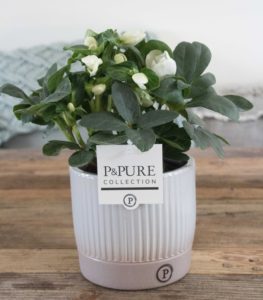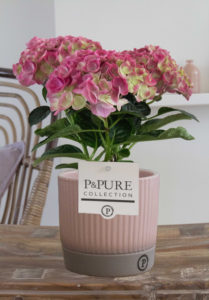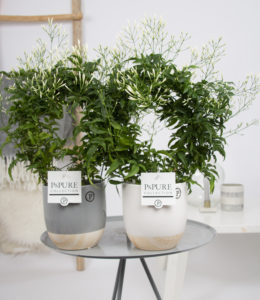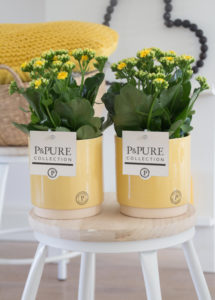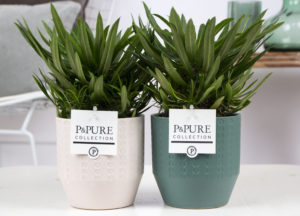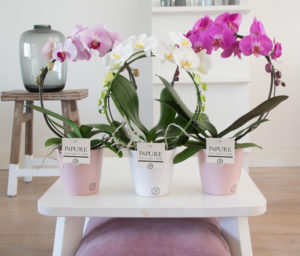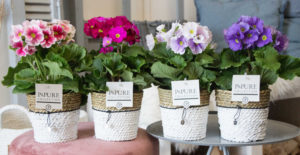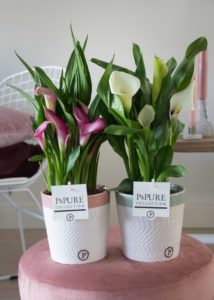Aloe vera
• Good light, but no bright sunlight.
• Keep damp, compost must not dry out.
• Keep plant slightly dry in winter.
• Fertiliser not necessary.
• Can be placed outside in summer.
• The plant is purely decorative and not suitable for consumption.
Amaryllis
During the growth process of the flowerbud, moderate watering is enough. Once a week
in little bits will be sufficient to keep the soil from drying out completely. If Amaryllis gets too
much water in this stage, its stems will grow larger and larger until they kink. After the flowers have
opened, you can give some extra water in order to keep the flowers from drooping.
Room temperature is fine. Unlike most other plants, Amaryllis can be kept close to or even just above
the radiators of your central heating. It will need a little extra water though!
The plant is purely decorative and not suitable for consumption.
Anthurium
• Anthuriums are very easy to care for.
• The plant needs a light position, but not in direct sunlight.
• A room temperature of 18-22 °C is fine – the plant may not get too cold.
• Water the plant regularly, ensuring that the water is not too cold. The soil should not be allowed to dry out, but too much water is not good either.
• The plant likes it if you regularly spray the leaves with tepid water.
• Plant food will ensure that the plant continues to flower profusely for a long time and continues to produces new buds. Feed the plant once every three weeks, in the correct concentration as specified on the packaging.
• It is a good idea to remove spent flowers.
• To keep the plant flowering for a number of years, it must have a rest period during the winter. Place the plant in a light spot at a temperature of 15 °C for around six weeks, after which it will reward you with profuse flowering.
• In the summer when the temperature no longer falls below 12 °C the plant can also be placed in the garden or on the patio.
• Anthurium will continue to thrive for between 4 and 26 weeks (depending on country of sale, shipping and storage time, ripeness, freshness, the provision of plant food and conditions at the consumer).
• The plant is purely decorative and not suitable for consumption.
Ardisia
• Much light, can stand some sunlight.
• Water moderately, slightly in winter.
• Water moderately, slightly in winter.
• The plant is purely decorative and not suitable for consumption.
Azalea
• Good light, but no bright sunlight.
• Ideal temperature 15-22 ºC.
• Keep damp, compost must not dry out.
• Do not leave excess water in saucer/dish.
• Fertiliser not necessary.
• The plant is purely decorative and not suitable for consumption.
Beaucarnea
The ideal temperature for this plant is ± 20 ºC (room temperature). It can survive lower temperatures during
the winter down to a minimum of 10?C. The Ponytail Palm needs a light, well-ventilated, sunny position but should
not be placed in direct sunlight. It requires little water because the plant stores water in the bulbous part of
the lower stem, Therefore it can even survive a period without water. The plant should be given plant feed once
every 4 weeks between April and September. This can be added to the water, which should preferably have a
low-calcium content.
The plant is purely decorative and not suitable for consumption.
Begonia
Ensure that the Pure Collection Begonia receives good light, but avoid direct sunlight.
Without enough light, the Begonia will flower at irregular intervals.
Keep the potting compost moderately moist since the plant absorbs a great deal of water during flowering.
Watering the Begonia simply involves pouring the water onto the surface of the potting compost.
Add a little liquid fertiliser to this water on a regular basis.
Remove faded flowers regularly to prevent fungal growth and extend the Begonia’s flowering period.
The plant is purely decorative and not suitable for consumption.
Calluna
The Pure Collection Calluna heath plant really likes sunny places but will also shows her colorful face at shady places. Since the Calluna is considered as a “late bloomer”, it can be used upon late summer for a nice fall decoration around your house.
– The Calluna germinates from end of August till beginning of Winter.
– Regularly water is important; the ground should be always slightly damp.
– Please try to avoid standing water in the pot
– Even in winter, the Calluna should stay in slightly
– Please note that the plant is for decoration only and not for consumption.
Calocephalus
The Pure Collection Calocephalus is comfortable with sunny and shady places. The silvery foliage displays gives throughout late summer a beautiful color contrast. Also in the Christmas period the silver Calocephalus brings a ornamental value.
– Additionally to the decorative silver foliage of the Pure Collection Calocephalus, there appears an globular inflorescence.
– Regularly water is important, the ground should be always slightly damp.
– Please try to avoid standing water in the pot
– It is winter proofed but the ground shall be slightly damped even during winter time.
– Please note that plant is for decoration only and not for consumption
Campanula
• Good light, but no bright sunlight.
• Flowers all year round.
• Remove dead heads of flowers.
• The plant is purely decorative and not suitable for consumption.
Corokia
Flowering: Corokia has little, yellow flowers which are flowering from April up to including May.
As a garden plant: hardy
As a terrace plant: keep inside during frost. Keep the soil moist.
As a house plant: keep the soil well moist and spray once a week.Fertilize in spring and in summer.
Pruning advice: cut back the long shoots as a house plant.
Position: full sun to half shade.
The plant is purely decorative and not suitable for consumption.
Crassula
• Requires little attention.
• Long lasting.
• Air purifying.
• Ideal temperature 5 – 30 ºC.
• Good light, but no bright sunlight.
• Apply fertiliser once a month.
• Do not leave excess water in saucer/dish.
• Keep plant slightly dry in winter.
• The plant is purely decorative and not suitable for consumption.
Cyclamen
The Cyclamen comes from the cool mountainous regions around the Mediterranean and belongs to the Primulaceae family.
The plant needs to be kept at a temperature of approximately ± 20 ºC all year round. Place the Cyclamen in a cool light spot but avoid placing it in direct sunlight.
The plant will die off rapidly if kept in a spot that is too sunny or too warm. Ideally the plant should be watered with luke warm softened water and the water
should be poured into the drip tray or the outer pot. Leave the plant to stand for about 30 minutes and then remove any surplus water to prevent the roots from rotting.
If the potting compost is very dry submerge the potting compost in water. Feed the plant every two weeks during the growing period then reduce the amount
of plant food while the plant is flowering. To keep the plant in good condition make a point of removing any flowers that have wilted and any dead leaves;
wilted flowers and dead leaves should be broken off rather than cut off to prevent rotting. If the plant is properly cared for it will go on flowering for several months.
Repotting is best done in the autumn. In this case give the plant somewhat more water and place it in a somewhat warmer spot.
The best tips for caring for your plant:
• Good light, but no bright sunlight.
• Ideal temperature 16 – 20 ºC.
• Keep damp, compost must not dry out.
• Do not leave excess water in saucer/dish.
• Apply fertiliser twice a month in winter.
• Remove dead heads of flowers.
• Remove dead foliage.
• The plant is purely decorative and not suitable for consumption.
Cyperus
Location:The Pure Collection® Cyperus Zumula grows naturally in light and sunny spots. Be careful, though, with immediate light from the sun, for a grass easily dries out. Make sure your cat has access to it.
Water and nutrition: Your cat grass cannot have enough water. You can water it three or four times a week. It grows best with a high humidity of the air around it. To meet these wishes, you can spray water on its leaves every now and then.
Temperature: Cat grass likes average room temperatures of above 18 degrees Celsius. It cannot withstand the cold, and neither can it withstand extreme warmth, which puts it in danger by drying it out too much.
The plant is purely decorative and not suitable for consumption.
Daffodil Grape Hyacinth
The P&Pure hyacinth can easily tolerate sunlight but placing it near a window where it will receive direct sunlight will also mean additional warmth resulting in an increased growth rate. We thus advise a somewhat cooler place in your home.
This bulbous flower prefers damp soil so give it a splash of water twice a week. Giving hyacinths and grape hyacinths too much water, however, would not be advisable because this results in an overly tall stem. When the flower starts to bloom, give it a splash of water three times a week. Daffodils, however, can use somewhat more water. The best advice here is to keep their soil slightly moist at all times.
A room temperature from 7-22°C would be perfect. To extend their longevity, we advise not placing their pot above a radiator or next to a window with direct sunlight. These are places in your home that warm up quickly and would increase the rate of the plant’s growth.
Dendrobium
- Dendrobium Nobile tolerates a lot of light, but never place it in direct sunlight in the spring and summer. This plant prefers a cool, airy environment. The ideal temperature is between 15 and 20ºC.
- Just like other orchids, the Dendrobium Nobile may not be left too wet, but certainly also not dry. Watering every five days in summer is sufficient, while once every seven days is fine in winter.
- The best way of watering it is to immerse the plant in tepid tap water. Let the plant stand for a while in the water and then let it drip well.
- When in full bloom, the Nobile requires special orchid nutrients once every two weeks. You can halve the quantity in winter. They are soluble in water.
- Once the flower stem has finished blooming, the flowers will fall off of their own accord. Place the Dendrobium Nobile in a light place where the temperature in winter is between 10 and 15ºC.
- Simply water the Dendrobium Nobile as usual in this period, in other words don’t let it dry out. From a new shoot the orchid will again produce new flowers. As a rule this takes between eight and twelve months.
- The Dendrobium Nobile does not flourish well in an over-large pot, and can even remain in the same pot for two to three years. Re-potting is thus only necessary if the Dendrobium Nobile really doesn’t fit in the original pot any longer.
Euphorbia Trigona
• Good light, but no bright sunlight.
• Keep damp, compost must not dry out.
• Keep plant slightly dry in winter.
• Fertiliser not necessary.
• Can be placed outside in summer.
• The plant is purely decorative and not suitable for consumption.
Euphorbia milii
• Good light, but no bright sunlight.
• Keep damp, compost must not dry out.
• Keep plant slightly dry in winter.
• Fertiliser not necessary.
• Can be placed outside in summer.
• The plant is purely decorative and not suitable for consumption.
Ficus
Ideally the plant should be kept at a temperature of approximately 18 ºC all year round. Keep the Ficus in a constant
environment with plenty of light all year round but avoid placing it in direct sunlight. There also needs to be high
atmospheric humidity. Insufficient light, too much draught or a sudden change in temperature can cause yellowing and
leaf loss. Give the Ficus plenty of water but take care to prevent saturation and do not allow a clod of dry earth to
accumulate around the roots since both cause the plant to shed its leaves. Feed the plant with normal plant food while
the new leaves are growing. To keep the plant in good condition spray the leaves regularly to remove any dust.
It is a good idea to replace the potting compost on an annual basis. The plant itself only needs to be repotted
once every two or three years.
The plant is purely decorative and not suitable for consumption.
Gerbera
Put the plant in a light, sunny spot. Avoid direct sunlight and draughts. The ideal temperature for this plant
is approximately 22 ºC in the summer. During this period, the potting soil must be kept very moist.
However, the plant prefers a cool spot in the winter, around 5 ºC. Keep the plant somewhat drier then.
Give it plenty of water during the summer. Add some nutrients to the water once a fortnight.
Gradually place it in a warmer spot and give it more water. To keep the plant in top condition, spray it regularly
with water (poor in calcium); however, do not spray the flowers. The plant may be re-potted in April or May.
The plant is purely decorative and not suitable for consumption.
Gloxinia
Ensure that the Pure Collection Gloxinia receives good light, but no direct sunlight.
Keep the plant sufficiently moist.
The Gloxinia’s profuse flowering requires more than the average amount of water.
Water the surface of the potting compost beneath the leaves; avoid watering the plant’s flower buds.
For optimal ornamental value, you can pinch or snip out faded flowers.
This plant is suitable for decoration only and is not intended for consumption.
Groen Mix
The soil used for a Pure Collection plant mix should be allowed to become dry before watering it again. Don’t allow the soil to remain continuously wet since this will decrease the vitality and ornamental value of the plant.
Hedera
The Hedera’s pot ball should be kept moist in the spring and autumn. In the autumn and winter it will be
preferable to allow the pot ball to dry slightly between watering sessions. Sprinkle the plant with
water when the air is dry during the winter. Indoor Hedera plants thrive at room temperature.
Keep your Hedera healthy by adding plant food to the water once a month.
The plant is purely decorative and not suitable for consumption.
Helleborus
The Helleborus Niger Pure Collection® is made up of plants for partial shade, not full sun.
This plant can be placed indoors or outdoors and makes a beautiful sight on the terrace.
It will produce a series of pure white flowers from mid-November to the end of March.
To encourage more flowering, remove faded blooms.
Do not keep the soil too wet, but be sure to provide enough water each time you water the plant.
The plant prefers temperatures that are not too warm.
In the garden, the plant can tolerate freezing temperatures but requires a location with good drainage.
The plant is purely decorative and not suitable for consumption.
Helianthus
Location : Keep your Pure Collection® Helianthus nice and light, or even full sun. Inside in the window, outside on the terrace or in the garden.
Water and nutrition: Never let the clod dry out. The leaves will immediately start hanging. It is good to give lots of water, however make sure the roots do not stand in the water for longer than two hours.
Temperature: In a cool place the flowers remain fresh for a longer time, but the plant actually enjoys a warm place better.
The plant is purely decorative and not suitable for consumption.
Hydrangea
• Hydrangeas like lots of light and plenty of water! The plant prefers a well lit spot out of bright sunlight.
• The plant prefers fresh, fairly moist air so keep Hydrangeas away from the central heating. Avoid draughts and strong temperature fluctuations. The ideal temperature is 15 to 22 °C.
• Ensure the soil in the pot is kept moist. The plant will enjoy a plunge bath once or twice a week.
• Remove any excess water from the cache pot or bowl.
• Are the leaves/flowers looking limp? Immerse the plant in water for 15 minutes and the leaves and flowers will generally recover. This could take between one and two hours depending on how limp they have become. Stand in a cool spot for even better results.
• The plant is purely decorative and not suitable for consumption.
Jasmine
Pure Collection’s Jasmine requires a high level of indirect light to encourage its flowers to open properly. Bright direct sunlight, however, will shorten its flowering period once the flowers are open.
Keeping the plant at room temperature encourages the flowers to open, but a lower temperature will prolong the flowering period once the flowers are open.
Water the plant about twice a week (preferably with rainwater) when kept at room temperature, and once a week when kept at 10 degrees. The plant does not require large quantities of plant food.
Kalanchoe
• Kalanchoe is easy to care for.
• The plant requires a light or sunny position, which can be either indoors or outdoors, provided that the temperature remains about 12°C.
• The succulent leaf means that the plant does not need a lot of water – watering once a week is sufficient. Too much water can be damaging.
• Plant food should be given once every three weeks in order to ensure the plant flowers for as long and as profusely as possible. This will ensure that the plant continues to flower profusely for a long time and continues to produce new buds.
• Carefully remove the spent flowers. Thereby avoid damaging the buds.
• Kalanchoe will continue to thrive for between 4 and 16 weeks (depending on country of sale, shipping and storage time, ripeness, freshness, the provision of plant food and conditions at the consumer).
• The plant is purely decorative and not suitable for consumption.
Lavandula
Place your Lavandula somewhere sunny in your garden or on your terrace. It needs at least a couple of hours of sunlight every day.
Water and nutrition
Make certain that the soil in which you keep your lavender plants is well drained. This way they will remain healthy and fresh for a long time. Water them abundantly during growth and bloom. In the spring you had best add some long lasting fertiliser to the soil.
Temperature
This plant can stay outdoors all through winter. If severe frost sets in for a prolonged period of time, you could drape some tin foil around the pot for protection.
The plant is purely decorative and not suitable for consumption.
Lilium
The potted lily needs plenty of light but does not like bright sunlight.
The soil in the pot needs to be kept moist, and the lily will keep longest at a temperature between 15 and 20ºC.
Once flowers are past their best, we recommend you remove them in order to keep the lily as attractive as possible.
The potted lily will be happy on your balcony or patio during the summer months,
so that you can enjoy them indoors and out.
Once all the flowers have died off, plant the lily out in a sunny spot in the garden, and it will reappear next year.
The stains caused by the pollen if you accidentally touch the potted lily stamens can best be removed from your
clothing as follows:
Brush the pollen off your clothing Lay the clothing in the sun and the stains will disappear by themselves!
This will remove pollen stains from all types of fabrics. You can also first wash the stained clothing and then lay
it in the sun, once again the pollen will disappear.
The plant is purely decorative and not suitable for consumption.
Nephrolepis
The Nephrolepis grows well at temperatures above 65 F °, but slightly cooler temperatures may also be suitable.
The soil should remain damp, but too much dampness will cause root rot. We recommend one watering per week.
For a healthy Nephrolepis, we also recommend adding plant food to the water in the watering can once a month.
Pour water around the sides of the plant, as pouring it the middle can cause water to get caught at the bases of the
leaves, which can result in rot.
The plant is purely decorative and not suitable for consumption.
Oncidium
The Oncidium originally comes from Central and South America and belongs to the Orchidaceae family (orchids).
This is one of the largest plant families and has more than 20,000 known varieties. Give the plant a well-lit spot
but direct sunlight should be avoided from March through to September. Do not place the plant in a draughty room.
The ideal temperature is ±20 ºC (room temperature) throughout the year. Keep the plant quite moist and prevent the
pot ball from drying out. Ensure that excess water is removed from the pot or dish. If this is not done the roots
will be harmed. The plant can be kept a little drier in the winter. Give fertiliser once every fortnight during summer
and once a month in winter. The plant may be re-potted if it becomes pot-bound or if the ground is exhausted.
Once the plant has finished flowering it can be pruned back to a height of 20cm above the pot.
The plant will form new branches and in the right conditions it will flower again the following season.
The plant is purely decorative and not suitable for consumption.
Pachypodium
Do not provide water if the soil is still damp. Provide less water during the winter. Winter is also a period when you should not water if the soil is still damp. Light: The Pure Collection Pachypodium lamerei prefers a light to sunny location.
Pernettia
Plenty of light, can withstand full sun.
Keep the soil March through May. Is winter hardy.
The plant is purely decorative and not suitable for consumption.
Phalaenopsis
• Phalaenopsis grows best at a normal room temperature of 18-22 ºC.
• The plant needs to stand in a light spot. In the winter months the plant can tolerate direct sunlight. In the spring and summer the sun is too bright.
• The plant does not need a great deal of water: watering once a week is sufficient. Too much water can be damaging.
• Plant food or special orchid food will ensure that all the buds open and the plant continues to flower for a long time.
• After flowering cut the stem above the second node. The node is a thickening of the stem and is easily identified. After a while, a new branch will develop from the node. A new bud grows under each leaf, which will also flower. After flowering it is advisable to cut this branch above the second node as well. This will ensure that the plant continues to flower.
• If the plant cannot be encouraged to flower again, the plant should be placed in a somewhat cooler, light room (15-16 degrees Celsius) for a few months in order to encourage bud formation. The plant will respond as if it is dying, and grows a bud in order to ensure a subsequent generation. During this cold period the plant needs little water. When a new shoot forms, the plant can be put back in the warm room.
• Phalaenopsis will continue to thrive for between 4 and 26 weeks (depending on country of sale, shipping and storage time, ripeness, freshness, the provision of plant food or orchid food and conditions at the consumer).
• The plant is purely decorative and not suitable for consumption.
Phlebodium
The Phlebodium grows well at temperatures above 65 F °, but slightly cooler temperatures may also be suitable.
The soil should remain damp, but too much dampness will cause root rot. We recommend one watering per week.
For a healthy Phlebodium, we also recommend adding plant food to the water in the watering can once a month.
Pour water around the sides of the plant, as pouring it the middle can cause water to get caught at the bases of the
leaves, which can result in rot.
The plant is purely decorative and not suitable for consumption.
Primula
With its cheerful colours the Pure Collection Primula almost literally brings the sunshine to your home.
The plant likes a place in half shade.
It is important that you keep the soil moist.
With the right care, you can enjoy this beautiful Primula obconica for a long time and it will reward you too!
The plant is purely decorative and not suitable for consumption.
Rose
Care instructions for consumers
• The pot roses is a plant which flowers profusely and for a long time if it is properly cared for.
• Indoors the plant needs a light position, and a sunny position outdoors.
• Ensure that the pot soil never dries out – you should therefore water the plant regularly.
• Plant food or specialist rose food should be given once every 3 weeks to ensure long and profuse flowering.
• Carefully remove the spent flowers. Thereby avoid damaging the buds.
• If the plant is used indoors, it can be pruned back when it has finished flowering to about 5 centimetres above the pot soil and planted out in the garden. After about two months the pot rose will then flower very profusely again as a garden rose.
• When used as a garden plant, the pot rose can be pruned back in February to 5 cm above the soil. The plant will then flower outdoors between May and October. They can survive the winter, after which the plant will flower again the next year.
• Pot roses will continue to thrive for between 2 and 12 weeks (depending on country of sale, shipping and storage time, ripeness, freshness, the provision of plant food and conditions at the consumer).
• The plant is purely decorative and not suitable for consumption.
Silver-leaved Mix
The various silver-leaved PURE Collection plants are perfect for use in various locations ranging from full sun to shade. Their silver foliage provides a beautiful contrast. These plants also retain their ornamental value throughout the Christmas season.
Combination tip: the silver-leaved PURE Collection plants, the red berries of Gaultheria and a flowering Calluna make a lovely autumn table arrangement!
• Water regularly; the root ball should never become dry.
• Make sure than no excess water is left standing in the pot.
• Adding fertiliser is not necessary.
• These plants are fully hardy, but their root ball should not be allowed to become dry.
• These plants are suitable for decoration only and are not intended for consumption.
Skimmia
Evergreen ornamental shurb. Winter hardy. Compact growth. Grows to approx 30 cm in height. suitable for patio, balcony and garden. White flowers from May. Red berries from August until spring. Do not prune.Position: shady.
The plant is purely decorative and not suitable for consumption.
Spathiphyllum
• Spathiphyllum is easy to look after.
• Place the plant in a light spot, but not in direct sunlight.
• The plant should not be too cold – a room temperature of 18-22 °C is ideal.
• Water the plant regularly, ensuring that the water is not too cold. The pot soil should not be allowed to dry out. The plant will signal when it has too little water by drooping.
• The plant like it if you regularly spray the leaves with tepid water.
• Plant food is advisable to keep the plant looking good for a long time. Feed the plant once every three weeks, in the correct concentration as specified on the packaging. This will ensure that the plant continues to flower profusely and keeps producing fresh buds.
• Remove spent flower shoots.
• To keep the plant flowering for a number of years, it must have a rest period during the winter. Place the plant in a light spot at a temperature of 15 °C for around six weeks, after which it will reward you with profuse flowering. In the summer when the temperature no longer falls below 12 °C the plant can also be placed in the garden or on the patio.
• Spathiphyllum will continue to thrive for between 4 and 26 weeks (depending on country of sale, shipping and storage time, ripeness, freshness, the provision of plant food and conditions at the consumer).
• The plant is purely decorative and not suitable for consumption.
Torenia
Flowering period: May-October
General characteristics: a bit of a newcomer to the summer-flowering scene, the Torenia will provide your flower containers, pots and tubs with colour until deep into autumn.
Important: do not put this plant outside too early because it is very intolerant of cold temperatures.
Location / habitat: rich, moist soil; semi-shade and shade. To prevent leaf burn, do not place in a location that receives full sun at the hottest time of the day.
Care:
– not hardy, so do not place outside too early.
– use a moisture-retentive, well-draining potting compost.
– do not let the soil become dry.
– remove faded flowers regularly.
– suitable for a location in light or full shade.
– too much nitrogen can stimulate leaf development but not flowering.
African Violet
Plenty of light, no direct sunlight.
Water twice weekly
Do not allow soil to dry out
Leave no excess water in the pot/ saucer.
Feed once a month, and once every two months in winter.
Ideal temperature 18-22 ℃
Dead blooms should be removed.
The plant is purely decorative and not suitable for consumption
Zantedeschia
• Favourite plant for indoors and outdoors.
• Good light, but no bright sunlight.
• Do not leave excess water in saucer/dish.
• Apply fertiliser twice a month.
• After flowering can be planted without pot in a sunny spot in the garden.
• The plant is purely decorative and not suitable for consumption.

